
Our Lady of Fátima is a Catholic title of Mary, mother of Jesus, based on the Marian apparitions reported in 1917 by three shepherd children at the Cova da Iria in Fátima, Portugal. The three children were Lúcia dos Santos and her cousins Francisco and Jacinta Marto. José Alves Correia da Silva, Bishop of Leiria, declared the events worthy of belief on 13 October 1930.
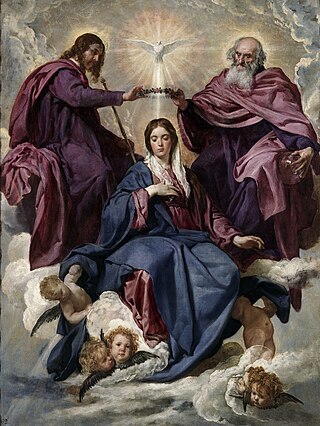
Queen of Heaven is a title given to the Virgin Mary, by Christians mainly of the Catholic Church and, to a lesser extent, in Anglicanism, Lutheranism, and Eastern Orthodoxy. The title has long been a tradition, included in prayers and devotional literature and seen in Western art in the subject of the Coronation of the Virgin from the High Middle Ages, long before it was given a formal definition status by the Church.

Our Lady of Sorrows, Our Lady of Dolours, the Sorrowful Mother or Mother of Sorrows, and Our Lady of Piety, Our Lady of the Seven Sorrows or Our Lady of the Seven Dolours are names by which Mary, mother of Jesus, is referred to in relation to sorrows in life. As Mater Dolorosa, it is also a key subject for Marian art in the Catholic Church.

Our Lady of the Rosary of Chiquinquirá or the Virgin of Chiquinquirá, is a Marian title of the Blessed Virgin Mary associated with a venerated image in the northern Andes region. She has been for centuries the highly appreciated patron saint of Colombia and adjacent regions of Venezuela, being the center of important traditional festivities at the beginning of Christmas, accompanied by local music.

The Nativity of the Blessed Virgin Mary, the Nativity of Mary, Marymas or the Birth of the Virgin Mary, refers to a Christian feast day celebrating the birth of Mary, mother of Jesus.

Our Lady of Mount Carmel, or Virgin of Carmel, is the title given to the Blessed Virgin Mary in her role as patroness of the Carmelite Order, particularly within the Catholic Church. The first Carmelites were Christian hermits living on Mount Carmel in the Holy Land during the late 12th and early to mid-13th century. They built in the midst of their hermitages a chapel which they dedicated to the Blessed Virgin, whom they conceived of in chivalric terms as the "Lady of the place." Our Lady of Mount Carmel was adopted in the 19th century as the patron saint of Chile.

Mary, the mother of Jesus in Christianity, is known by many different titles, epithets, invocations, and several names associated with places.

Our Lady of Manaoag is a Roman Catholic title of the Blessed Virgin Mary venerated in Manaoag, Pangasinan, the Philippines. The sacred statue is referred to as Apo Baket in the native language of local devotees.

May devotions to the Blessed Virgin Mary refer to special Marian devotions held in the Catholic Church during the month of May honoring Mary, mother of God, as "the Queen of May". These services may take place inside or outside. A "May Crowning" is a traditional Roman Catholic ritual that occurs in the month of May.

The veneration of Mary in the Catholic Church encompasses various devotions which include prayer, pious acts, visual arts, poetry, and music devoted to her. Popes have encouraged it, while also taking steps to reform some manifestations of it. The Holy See has insisted on the importance of distinguishing "true from false devotion, and authentic doctrine from its deformations by excess or defect". There are significantly more titles, feasts, and venerative Marian practices among Roman Catholics than in other Western Christian traditions. The term hyperdulia indicates the special veneration due to Mary, greater than the ordinary dulia for other saints, but utterly unlike the latria due only to God.
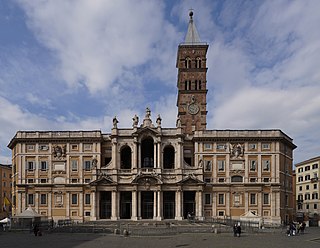
Catholic Marian churches are religious buildings dedicated to the veneration of the Blessed Virgin Mary. These churches were built throughout the history of the Catholic Church, and today they can be found on every continent including Antarctica. The history of Marian church architecture tells the unfolding story of the development of Catholic Mariology.
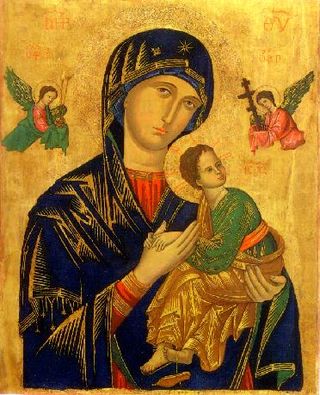
Mary has been one of the major subjects of Western art for centuries. There is an enormous quantity of Marian art in the Catholic Church, covering both devotional subjects such as the Virgin and Child and a range of narrative subjects from the Life of the Virgin, often arranged in cycles. Most medieval painters, and from the Reformation to about 1800 most from Catholic countries, have produced works, including old masters such as Michelangelo and Botticelli.

Our Lady of Caysasay is a Roman Catholic image of the Blessed Virgin Mary venerated at the Archdiocesan Shrine of Our Lady of Caysasay in Taal, Batangas, Philippines. The image depicts the Immaculate Conception is believed to be one of the oldest in the country, originally discovered in 1603 by a native man fishing in the Pansipit River. The subsequent Marian apparitions documented by Spanish colonial church leaders were the first in the country; devotees today continue to attribute miracles to the Virgin.

Our Lady of Peñafrancia is an image of the Blessed Virgin Mary in the Philippines. The Marian image is permanently enshrined in the Minor Basilica of Our Lady of Peñafrancia in Naga, Camarines Sur.

The Queen of Angels Foundation is an association of lay faithful of the Catholic Church dedicated to fostering devotion to Mary, Mother of Jesus. The Foundation is a volunteer group of lay men and women who "...strive together in a common endeavor to foster a more perfect life for themselves and their community by promoting reverence for the Blessed Virgin Mary, in whose name, as Our Lady of the Angels, the City and Archdiocese of Los Angeles were founded..." and whom Catholics revere as Queen of Heaven and Empress of the Americas.

Our Lady of the Most Holy Rosary, Queen of the Caracol, known locally as Mahal na Birhen ng Santo Rosaryo, Reyna ng Karakol or Nuestra Señora Virgen del Santissimo Rosario, Reina de Caracol, is the patroness of the Municipality of Rosario, formerly known as Salinas, in Cavite province, Philippines.

Our Lady of Peace and Good Voyage, also known as Our Lady of Antipolo and the Virgin of Antipolo, is a seventeenth-century Roman Catholic wooden image of the Blessed Virgin Mary as venerated in the Philippines. This Black Madonna is enshrined in Antipolo Cathedral in the Sierra Madre mountains east of Metro Manila.
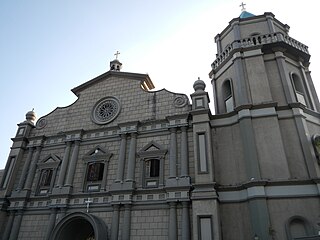
The Minor Basilica and Shrine Parish of Our Lady of the Rosary of Orani, commonly known as Orani Church, is a Roman Catholic minor basilica built in the Neoclassical style located in the center of Orani, Bataan, in the Philippines.

The Friday of Sorrows is a solemn pious remembrance of the sorrowful Blessed Virgin Mary on the Friday before Palm Sunday held in the fifth week of Lent. In the Anglican Ordinariate's Divine Worship: The Missal it is called Saint Mary in Passiontide and sometimes it is traditionally known as Our Lady in Passiontide.
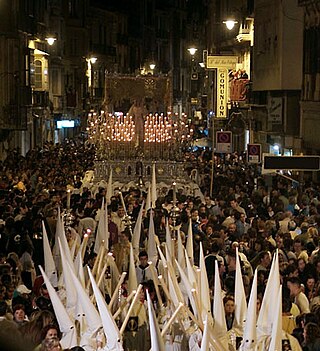
Holy Week in Málaga, is the annual commemoration of the Passion of Jesus in Málaga, Spain. It takes place during the last week of Lent, the week immediately before Easter. It is one of the city's main cultural and religious events.






















